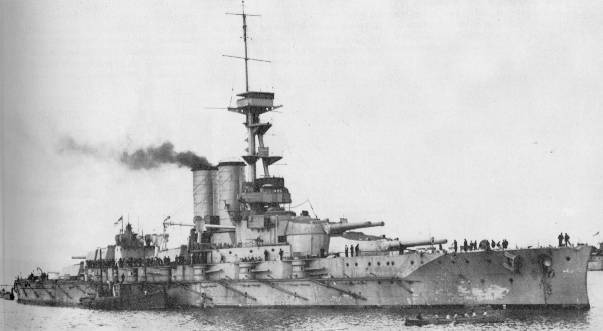Another 6" (15.2 cm) gun designed for the foreign markets by Vickers, this one was for the Turkish battleship Reshadieh. This ship was taken over by Britain at the start of World War I and renamed HMS Erin.
During World War II, these guns were used in emergency coastal batteries.
This gun has the distinction of having the highest muzzle velocity of any British 6" (15.2 cm) used without super charges.
Similar to other Vickers wire guns with cannelured rings except that the wire was used only part way, with the B tube directly over the A tube forward of the jacket. The reserve guns, which never went to sea, differed in having a tapered inner A tube. Used a hand-worked Welin breech-block. A total of 19 guns were produced.
| Designation | 6"/50 (15.2 cm) BL Mark XVI |
|---|---|
| Ship Class Used On | Erin |
| Date Of Design | 1913 |
| Date In Service | 1914 |
| Gun Weight | 18,904 lbs. (8,275 kg) |
| Gun Length oa | 310.1 in (7.876 m) |
| Bore Length | 300.0 in (7.620 m) |
| Rifling Length | N/A |
| Grooves | N/A |
| Lands | N/A |
| Twist | N/A |
| Chamber Volume | 1,910 in3 (31.30 dm3) |
| Rate Of Fire | 5 - 7 rounds per minute 1 2 |
- ^
The Rate of Fire figure given above is found in references for British guns of this caliber, but "Warrior to Dreadnought: Warship Development 1860-1905" quotes Jellicoe's 1906 figures for rates of fire for these guns in gunlayers' tests and in battle practice and notes that the latter figures corresponded well to those actually attained by the Japanese at Tsushima:
Gunlayers Test 12 rounds per minute Battle Practice 4 rounds per minute - ^In "Jutland: An Analysis of the Fighting" by John Campbell, it is stated that almost all British capital ships had few or slow hoists for their 6" (15.2 cm) guns and that once the ready ammunition was used up, the rate of fire dropped to about 3 rounds per minute.
| Type | Bag |
|---|---|
| Projectile Types and Weights | CPC 4crh: 100 lbs. (45.3 kg) HE 4crh: 100 lbs. (45.3 kg) |
| Bursting Charge | CPC: 7.5 lbs. (3.4 kg) HE: 13.3 lbs. (6.0 kg) |
| Projectile Length | CPC: 23.5 in (59.7 cm) HE: 22.9 in (58.2 cm) |
| Propellant Charge | 32.9 lbs. (14.93 kg) SC |
| Muzzle Velocity | 3,000 fps (914 mps) |
| Working Pressure | N/A |
| Approximate Barrel Life | N/A |
| Ammunition stowage per gun | 150 rounds |
| Designation |
|
|---|---|
| Weight (less shield) | N/A |
| Elevation | PX: -7 / +15 degrees |
| Elevation Rate | Manual operation, only |
| Train | about +80 / -80 degrees |
| Train Rate | Manual operation, only |
| Gun recoil | N/A |
The gun ports for these guns were poorly designed and were considered to be shell traps. On the other hand the Vickers mountings allowed very good arcs of fire and better elevations over that arc than was the case for Admiralty designs.
Data from:
- "Warrior to Dreadnought: Warship Development 1860-1905" by D.K. Brown
- "British Battleships of World War One" by R.A. Burt
- "Naval Weapons of World War Two" and "British Naval Guns 1880-1945 No 12" article in "Warship Volume VIII" both by John Campbell
- "British Cruisers of World War Two" by Alan Raven and John Roberts
- "A Concentrated Effort: Royal Navy Gunnery Exercises at the End of the Great War" article by William Schleihauf in "Warship International" No. 2, 1998
- 07 January 2007
- Benchmark
- 30 January 2009
- Added construction details
- 04 February 2014
- Added ammunition stowage and mounting note

